Introduction to Micro Economics: A Comprehensive Overview
VerifiedAdded on 2021/06/07
|35
|14975
|121
Homework Assignment
AI Summary
This assignment provides an introduction to micro economics, beginning with the fundamental question of what economics is about, using a birthday gift scenario to illustrate the concept of scarcity and choices. It defines economics as the study of how scarce resources are used to satisfy unlimited wants. The document reviews different definitions of economics, including the science of wealth (Adam Smith), the science of material well-being (Alfred Marshall), and the science of choice-making (Lionel Robbins). It discusses the merits and criticisms of each definition, highlighting the evolution of economic thought. The assignment also covers the scope of economics, addressing the allocation of scarce resources, the growth of productive capacity, and fluctuations in resource utilization. It concludes by emphasizing the importance of economics in analyzing economic problems and suggesting potential solutions, while acknowledging the complexity of these issues and the influence of non-economic factors. The content is designed to provide a foundational understanding of microeconomics, suitable for introductory courses like the CA Foundation.
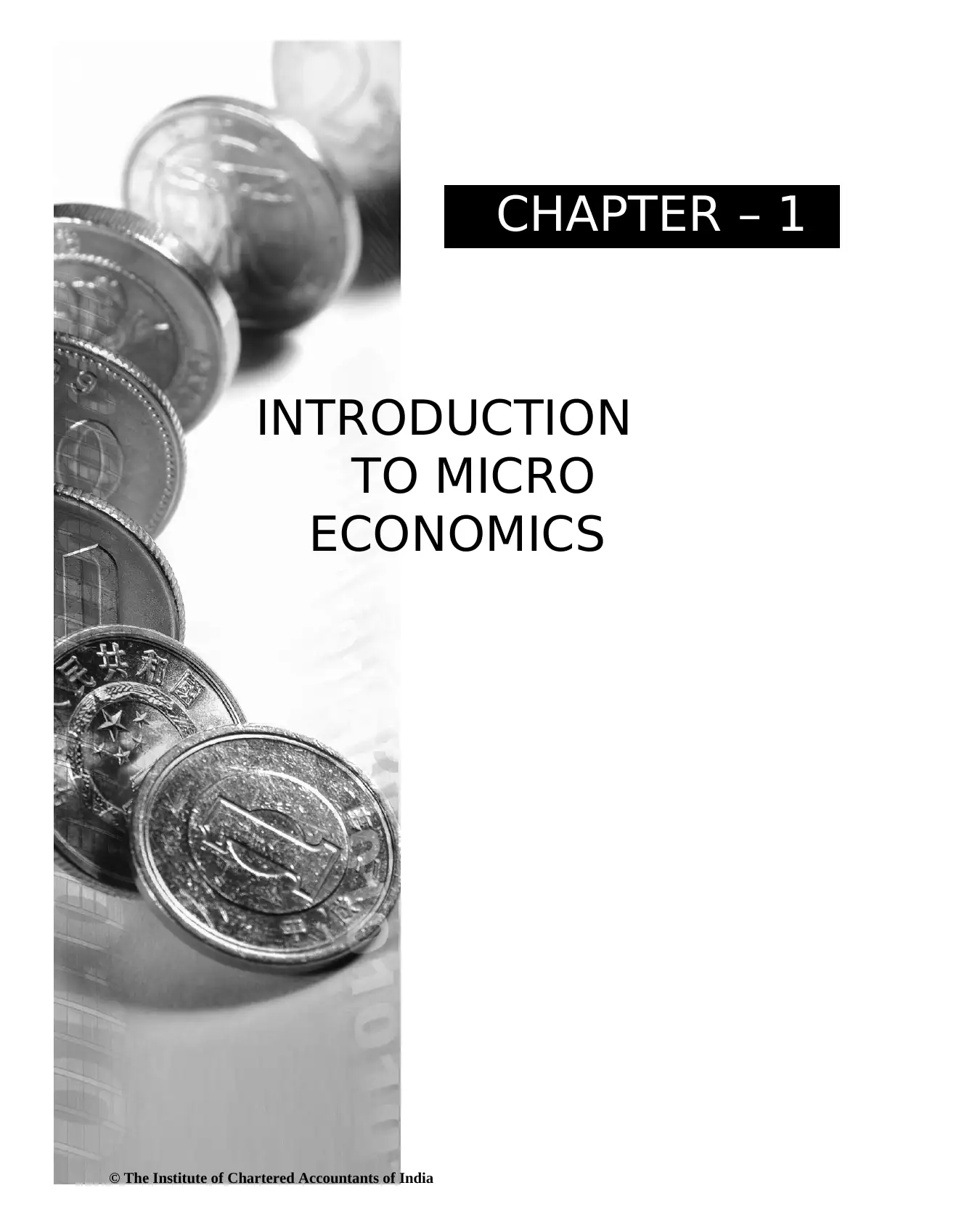
CHAPTER – 1
INTRODUCTION
TO MICRO
ECONOMICS
© The Institute of Chartered Accountants of India
INTRODUCTION
TO MICRO
ECONOMICS
© The Institute of Chartered Accountants of India
Paraphrase This Document
Need a fresh take? Get an instant paraphrase of this document with our AI Paraphraser
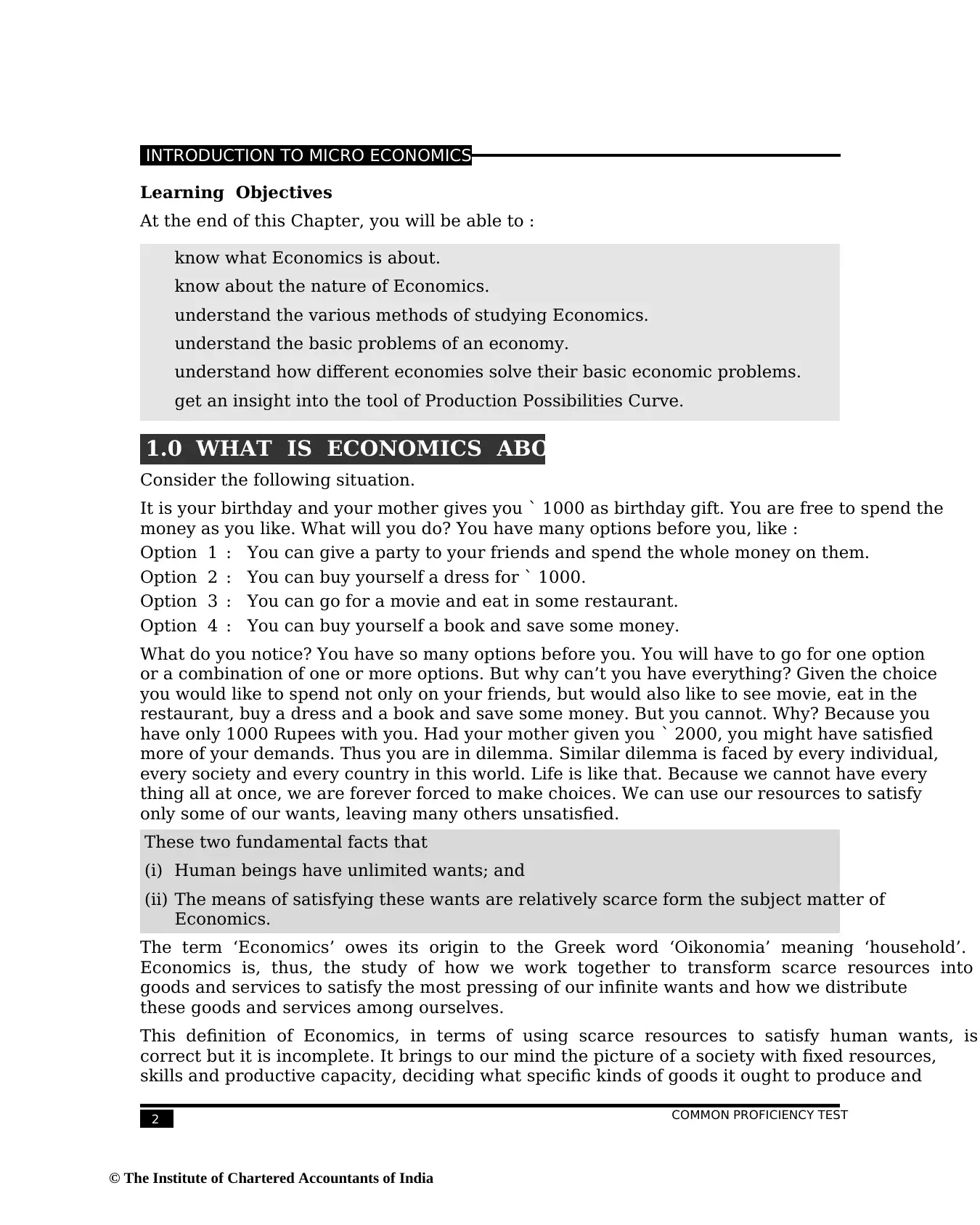
2
INTRODUCTION TO MICRO ECONOMICS
COMMON PROFICIENCY TEST
Learning Objectives
At the end of this Chapter, you will be able to :
know what Economics is about.
know about the nature of Economics.
understand the various methods of studying Economics.
understand the basic problems of an economy.
understand how different economies solve their basic economic problems.
get an insight into the tool of Production Possibilities Curve.
1.0 WHAT IS ECONOMICS ABOUT?
Consider the following situation.
It is your birthday and your mother gives you ` 1000 as birthday gift. You are free to spend the
money as you like. What will you do? You have many options before you, like :
Option 1 : You can give a party to your friends and spend the whole money on them.
Option 2 : You can buy yourself a dress for ` 1000.
Option 3 : You can go for a movie and eat in some restaurant.
Option 4 : You can buy yourself a book and save some money.
What do you notice? You have so many options before you. You will have to go for one option
or a combination of one or more options. But why can’t you have everything? Given the choice
you would like to spend not only on your friends, but would also like to see movie, eat in the
restaurant, buy a dress and a book and save some money. But you cannot. Why? Because you
have only 1000 Rupees with you. Had your mother given you ` 2000, you might have satisfied
more of your demands. Thus you are in dilemma. Similar dilemma is faced by every individual,
every society and every country in this world. Life is like that. Because we cannot have every
thing all at once, we are forever forced to make choices. We can use our resources to satisfy
only some of our wants, leaving many others unsatisfied.
These two fundamental facts that
(i) Human beings have unlimited wants; and
(ii) The means of satisfying these wants are relatively scarce form the subject matter of
Economics.
The term ‘Economics’ owes its origin to the Greek word ‘Oikonomia’ meaning ‘household’.
Economics is, thus, the study of how we work together to transform scarce resources into
goods and services to satisfy the most pressing of our infinite wants and how we distribute
these goods and services among ourselves.
This definition of Economics, in terms of using scarce resources to satisfy human wants, is
correct but it is incomplete. It brings to our mind the picture of a society with fixed resources,
skills and productive capacity, deciding what specific kinds of goods it ought to produce and
© The Institute of Chartered Accountants of India
INTRODUCTION TO MICRO ECONOMICS
COMMON PROFICIENCY TEST
Learning Objectives
At the end of this Chapter, you will be able to :
know what Economics is about.
know about the nature of Economics.
understand the various methods of studying Economics.
understand the basic problems of an economy.
understand how different economies solve their basic economic problems.
get an insight into the tool of Production Possibilities Curve.
1.0 WHAT IS ECONOMICS ABOUT?
Consider the following situation.
It is your birthday and your mother gives you ` 1000 as birthday gift. You are free to spend the
money as you like. What will you do? You have many options before you, like :
Option 1 : You can give a party to your friends and spend the whole money on them.
Option 2 : You can buy yourself a dress for ` 1000.
Option 3 : You can go for a movie and eat in some restaurant.
Option 4 : You can buy yourself a book and save some money.
What do you notice? You have so many options before you. You will have to go for one option
or a combination of one or more options. But why can’t you have everything? Given the choice
you would like to spend not only on your friends, but would also like to see movie, eat in the
restaurant, buy a dress and a book and save some money. But you cannot. Why? Because you
have only 1000 Rupees with you. Had your mother given you ` 2000, you might have satisfied
more of your demands. Thus you are in dilemma. Similar dilemma is faced by every individual,
every society and every country in this world. Life is like that. Because we cannot have every
thing all at once, we are forever forced to make choices. We can use our resources to satisfy
only some of our wants, leaving many others unsatisfied.
These two fundamental facts that
(i) Human beings have unlimited wants; and
(ii) The means of satisfying these wants are relatively scarce form the subject matter of
Economics.
The term ‘Economics’ owes its origin to the Greek word ‘Oikonomia’ meaning ‘household’.
Economics is, thus, the study of how we work together to transform scarce resources into
goods and services to satisfy the most pressing of our infinite wants and how we distribute
these goods and services among ourselves.
This definition of Economics, in terms of using scarce resources to satisfy human wants, is
correct but it is incomplete. It brings to our mind the picture of a society with fixed resources,
skills and productive capacity, deciding what specific kinds of goods it ought to produce and
© The Institute of Chartered Accountants of India
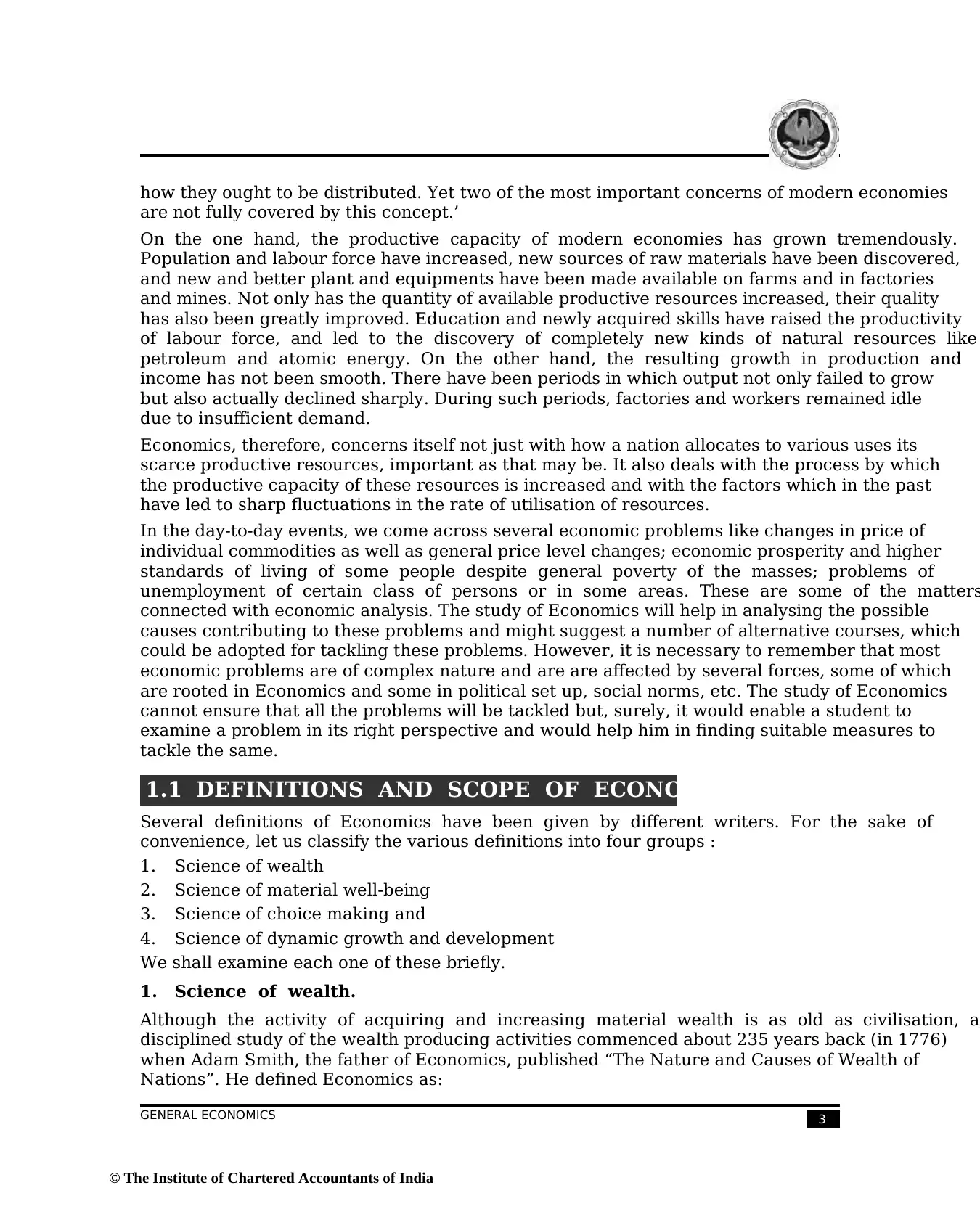
GENERAL ECONOMICS 3
how they ought to be distributed. Yet two of the most important concerns of modern economies
are not fully covered by this concept.’
On the one hand, the productive capacity of modern economies has grown tremendously.
Population and labour force have increased, new sources of raw materials have been discovered,
and new and better plant and equipments have been made available on farms and in factories
and mines. Not only has the quantity of available productive resources increased, their quality
has also been greatly improved. Education and newly acquired skills have raised the productivity
of labour force, and led to the discovery of completely new kinds of natural resources like
petroleum and atomic energy. On the other hand, the resulting growth in production and
income has not been smooth. There have been periods in which output not only failed to grow
but also actually declined sharply. During such periods, factories and workers remained idle
due to insufficient demand.
Economics, therefore, concerns itself not just with how a nation allocates to various uses its
scarce productive resources, important as that may be. It also deals with the process by which
the productive capacity of these resources is increased and with the factors which in the past
have led to sharp fluctuations in the rate of utilisation of resources.
In the day-to-day events, we come across several economic problems like changes in price of
individual commodities as well as general price level changes; economic prosperity and higher
standards of living of some people despite general poverty of the masses; problems of
unemployment of certain class of persons or in some areas. These are some of the matters
connected with economic analysis. The study of Economics will help in analysing the possible
causes contributing to these problems and might suggest a number of alternative courses, which
could be adopted for tackling these problems. However, it is necessary to remember that most
economic problems are of complex nature and are are affected by several forces, some of which
are rooted in Economics and some in political set up, social norms, etc. The study of Economics
cannot ensure that all the problems will be tackled but, surely, it would enable a student to
examine a problem in its right perspective and would help him in finding suitable measures to
tackle the same.
1.1 DEFINITIONS AND SCOPE OF ECONOMICS
Several definitions of Economics have been given by different writers. For the sake of
convenience, let us classify the various definitions into four groups :
1. Science of wealth
2. Science of material well-being
3. Science of choice making and
4. Science of dynamic growth and development
We shall examine each one of these briefly.
1. Science of wealth.
Although the activity of acquiring and increasing material wealth is as old as civilisation, a
disciplined study of the wealth producing activities commenced about 235 years back (in 1776)
when Adam Smith, the father of Economics, published “The Nature and Causes of Wealth of
Nations”. He defined Economics as:
© The Institute of Chartered Accountants of India
how they ought to be distributed. Yet two of the most important concerns of modern economies
are not fully covered by this concept.’
On the one hand, the productive capacity of modern economies has grown tremendously.
Population and labour force have increased, new sources of raw materials have been discovered,
and new and better plant and equipments have been made available on farms and in factories
and mines. Not only has the quantity of available productive resources increased, their quality
has also been greatly improved. Education and newly acquired skills have raised the productivity
of labour force, and led to the discovery of completely new kinds of natural resources like
petroleum and atomic energy. On the other hand, the resulting growth in production and
income has not been smooth. There have been periods in which output not only failed to grow
but also actually declined sharply. During such periods, factories and workers remained idle
due to insufficient demand.
Economics, therefore, concerns itself not just with how a nation allocates to various uses its
scarce productive resources, important as that may be. It also deals with the process by which
the productive capacity of these resources is increased and with the factors which in the past
have led to sharp fluctuations in the rate of utilisation of resources.
In the day-to-day events, we come across several economic problems like changes in price of
individual commodities as well as general price level changes; economic prosperity and higher
standards of living of some people despite general poverty of the masses; problems of
unemployment of certain class of persons or in some areas. These are some of the matters
connected with economic analysis. The study of Economics will help in analysing the possible
causes contributing to these problems and might suggest a number of alternative courses, which
could be adopted for tackling these problems. However, it is necessary to remember that most
economic problems are of complex nature and are are affected by several forces, some of which
are rooted in Economics and some in political set up, social norms, etc. The study of Economics
cannot ensure that all the problems will be tackled but, surely, it would enable a student to
examine a problem in its right perspective and would help him in finding suitable measures to
tackle the same.
1.1 DEFINITIONS AND SCOPE OF ECONOMICS
Several definitions of Economics have been given by different writers. For the sake of
convenience, let us classify the various definitions into four groups :
1. Science of wealth
2. Science of material well-being
3. Science of choice making and
4. Science of dynamic growth and development
We shall examine each one of these briefly.
1. Science of wealth.
Although the activity of acquiring and increasing material wealth is as old as civilisation, a
disciplined study of the wealth producing activities commenced about 235 years back (in 1776)
when Adam Smith, the father of Economics, published “The Nature and Causes of Wealth of
Nations”. He defined Economics as:
© The Institute of Chartered Accountants of India
⊘ This is a preview!⊘
Do you want full access?
Subscribe today to unlock all pages.

Trusted by 1+ million students worldwide
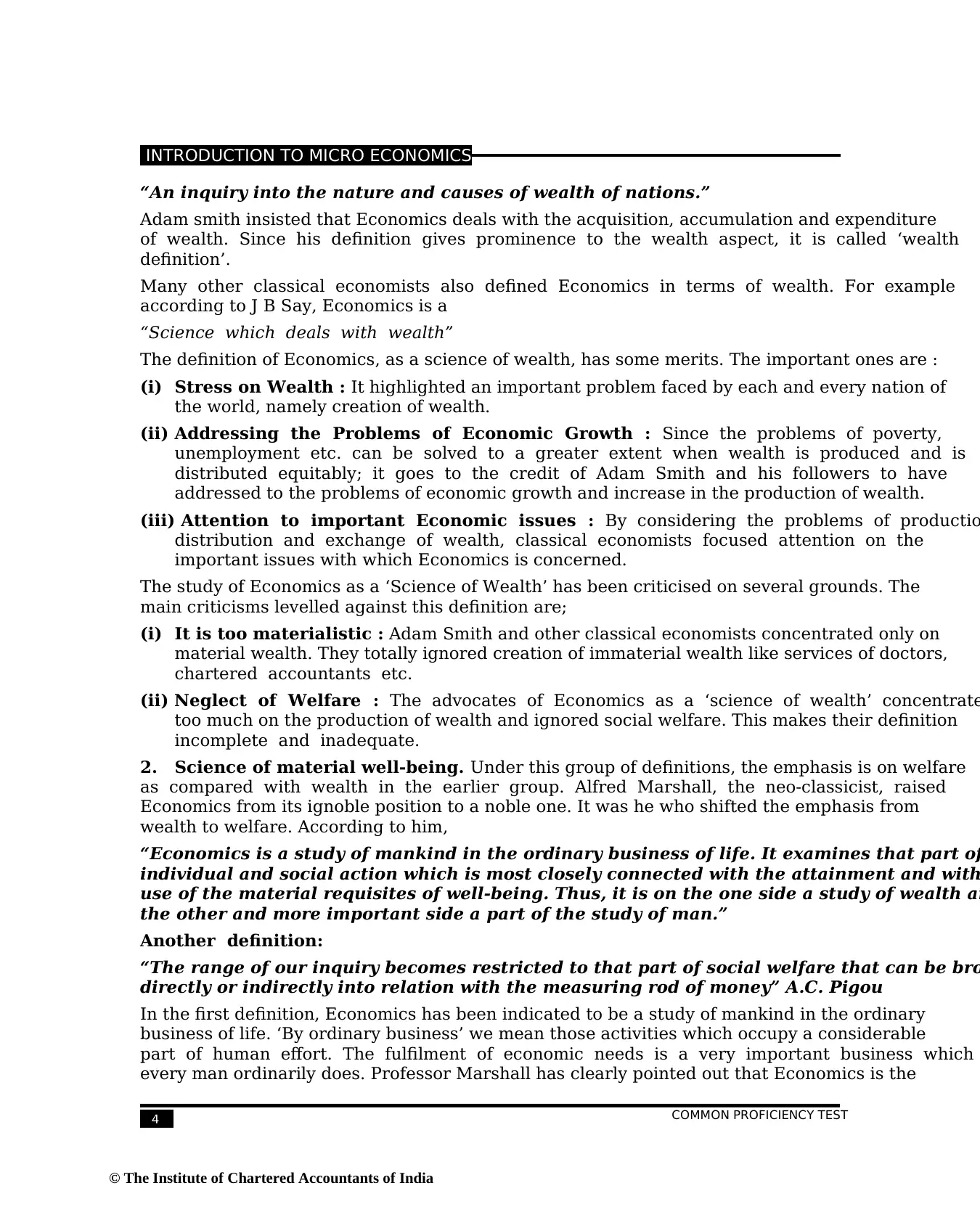
4
INTRODUCTION TO MICRO ECONOMICS
COMMON PROFICIENCY TEST
“An inquiry into the nature and causes of wealth of nations.”
Adam smith insisted that Economics deals with the acquisition, accumulation and expenditure
of wealth. Since his definition gives prominence to the wealth aspect, it is called ‘wealth
definition’.
Many other classical economists also defined Economics in terms of wealth. For example
according to J B Say, Economics is a
“Science which deals with wealth”
The definition of Economics, as a science of wealth, has some merits. The important ones are :
(i) Stress on Wealth : It highlighted an important problem faced by each and every nation of
the world, namely creation of wealth.
(ii) Addressing the Problems of Economic Growth : Since the problems of poverty,
unemployment etc. can be solved to a greater extent when wealth is produced and is
distributed equitably; it goes to the credit of Adam Smith and his followers to have
addressed to the problems of economic growth and increase in the production of wealth.
(iii) Attention to important Economic issues : By considering the problems of productio
distribution and exchange of wealth, classical economists focused attention on the
important issues with which Economics is concerned.
The study of Economics as a ‘Science of Wealth’ has been criticised on several grounds. The
main criticisms levelled against this definition are;
(i) It is too materialistic : Adam Smith and other classical economists concentrated only on
material wealth. They totally ignored creation of immaterial wealth like services of doctors,
chartered accountants etc.
(ii) Neglect of Welfare : The advocates of Economics as a ‘science of wealth’ concentrate
too much on the production of wealth and ignored social welfare. This makes their definition
incomplete and inadequate.
2. Science of material well-being. Under this group of definitions, the emphasis is on welfare
as compared with wealth in the earlier group. Alfred Marshall, the neo-classicist, raised
Economics from its ignoble position to a noble one. It was he who shifted the emphasis from
wealth to welfare. According to him,
“Economics is a study of mankind in the ordinary business of life. It examines that part of
individual and social action which is most closely connected with the attainment and with
use of the material requisites of well-being. Thus, it is on the one side a study of wealth an
the other and more important side a part of the study of man.”
Another definition:
“The range of our inquiry becomes restricted to that part of social welfare that can be bro
directly or indirectly into relation with the measuring rod of money” A.C. Pigou
In the first definition, Economics has been indicated to be a study of mankind in the ordinary
business of life. ‘By ordinary business’ we mean those activities which occupy a considerable
part of human effort. The fulfilment of economic needs is a very important business which
every man ordinarily does. Professor Marshall has clearly pointed out that Economics is the
© The Institute of Chartered Accountants of India
INTRODUCTION TO MICRO ECONOMICS
COMMON PROFICIENCY TEST
“An inquiry into the nature and causes of wealth of nations.”
Adam smith insisted that Economics deals with the acquisition, accumulation and expenditure
of wealth. Since his definition gives prominence to the wealth aspect, it is called ‘wealth
definition’.
Many other classical economists also defined Economics in terms of wealth. For example
according to J B Say, Economics is a
“Science which deals with wealth”
The definition of Economics, as a science of wealth, has some merits. The important ones are :
(i) Stress on Wealth : It highlighted an important problem faced by each and every nation of
the world, namely creation of wealth.
(ii) Addressing the Problems of Economic Growth : Since the problems of poverty,
unemployment etc. can be solved to a greater extent when wealth is produced and is
distributed equitably; it goes to the credit of Adam Smith and his followers to have
addressed to the problems of economic growth and increase in the production of wealth.
(iii) Attention to important Economic issues : By considering the problems of productio
distribution and exchange of wealth, classical economists focused attention on the
important issues with which Economics is concerned.
The study of Economics as a ‘Science of Wealth’ has been criticised on several grounds. The
main criticisms levelled against this definition are;
(i) It is too materialistic : Adam Smith and other classical economists concentrated only on
material wealth. They totally ignored creation of immaterial wealth like services of doctors,
chartered accountants etc.
(ii) Neglect of Welfare : The advocates of Economics as a ‘science of wealth’ concentrate
too much on the production of wealth and ignored social welfare. This makes their definition
incomplete and inadequate.
2. Science of material well-being. Under this group of definitions, the emphasis is on welfare
as compared with wealth in the earlier group. Alfred Marshall, the neo-classicist, raised
Economics from its ignoble position to a noble one. It was he who shifted the emphasis from
wealth to welfare. According to him,
“Economics is a study of mankind in the ordinary business of life. It examines that part of
individual and social action which is most closely connected with the attainment and with
use of the material requisites of well-being. Thus, it is on the one side a study of wealth an
the other and more important side a part of the study of man.”
Another definition:
“The range of our inquiry becomes restricted to that part of social welfare that can be bro
directly or indirectly into relation with the measuring rod of money” A.C. Pigou
In the first definition, Economics has been indicated to be a study of mankind in the ordinary
business of life. ‘By ordinary business’ we mean those activities which occupy a considerable
part of human effort. The fulfilment of economic needs is a very important business which
every man ordinarily does. Professor Marshall has clearly pointed out that Economics is the
© The Institute of Chartered Accountants of India
Paraphrase This Document
Need a fresh take? Get an instant paraphrase of this document with our AI Paraphraser
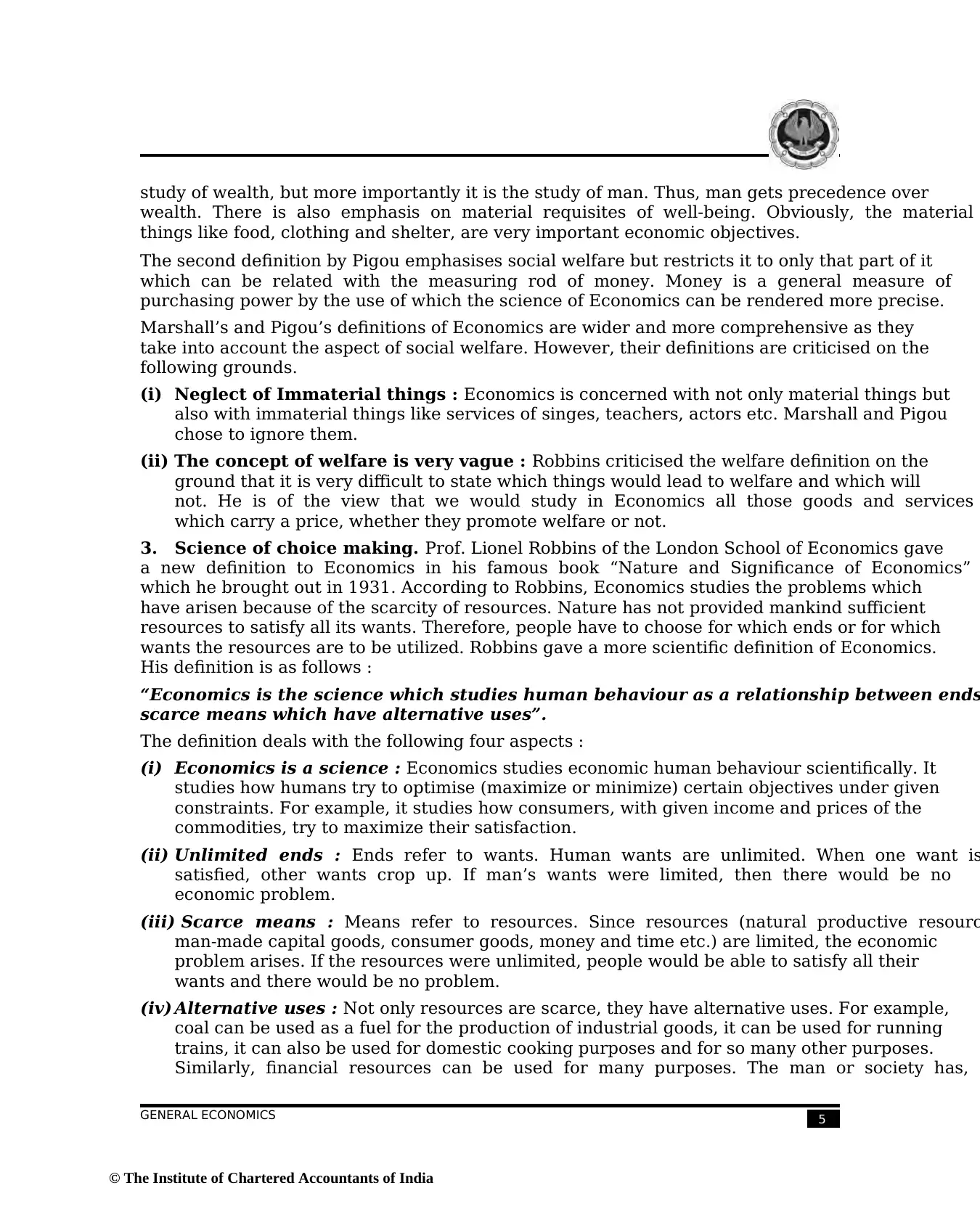
GENERAL ECONOMICS 5
study of wealth, but more importantly it is the study of man. Thus, man gets precedence over
wealth. There is also emphasis on material requisites of well-being. Obviously, the material
things like food, clothing and shelter, are very important economic objectives.
The second definition by Pigou emphasises social welfare but restricts it to only that part of it
which can be related with the measuring rod of money. Money is a general measure of
purchasing power by the use of which the science of Economics can be rendered more precise.
Marshall’s and Pigou’s definitions of Economics are wider and more comprehensive as they
take into account the aspect of social welfare. However, their definitions are criticised on the
following grounds.
(i) Neglect of Immaterial things : Economics is concerned with not only material things but
also with immaterial things like services of singes, teachers, actors etc. Marshall and Pigou
chose to ignore them.
(ii) The concept of welfare is very vague : Robbins criticised the welfare definition on the
ground that it is very difficult to state which things would lead to welfare and which will
not. He is of the view that we would study in Economics all those goods and services
which carry a price, whether they promote welfare or not.
3. Science of choice making. Prof. Lionel Robbins of the London School of Economics gave
a new definition to Economics in his famous book “Nature and Significance of Economics”
which he brought out in 1931. According to Robbins, Economics studies the problems which
have arisen because of the scarcity of resources. Nature has not provided mankind sufficient
resources to satisfy all its wants. Therefore, people have to choose for which ends or for which
wants the resources are to be utilized. Robbins gave a more scientific definition of Economics.
His definition is as follows :
“Economics is the science which studies human behaviour as a relationship between ends
scarce means which have alternative uses”.
The definition deals with the following four aspects :
(i) Economics is a science : Economics studies economic human behaviour scientifically. It
studies how humans try to optimise (maximize or minimize) certain objectives under given
constraints. For example, it studies how consumers, with given income and prices of the
commodities, try to maximize their satisfaction.
(ii) Unlimited ends : Ends refer to wants. Human wants are unlimited. When one want is
satisfied, other wants crop up. If man’s wants were limited, then there would be no
economic problem.
(iii) Scarce means : Means refer to resources. Since resources (natural productive resourc
man-made capital goods, consumer goods, money and time etc.) are limited, the economic
problem arises. If the resources were unlimited, people would be able to satisfy all their
wants and there would be no problem.
(iv) Alternative uses : Not only resources are scarce, they have alternative uses. For example,
coal can be used as a fuel for the production of industrial goods, it can be used for running
trains, it can also be used for domestic cooking purposes and for so many other purposes.
Similarly, financial resources can be used for many purposes. The man or society has,
© The Institute of Chartered Accountants of India
study of wealth, but more importantly it is the study of man. Thus, man gets precedence over
wealth. There is also emphasis on material requisites of well-being. Obviously, the material
things like food, clothing and shelter, are very important economic objectives.
The second definition by Pigou emphasises social welfare but restricts it to only that part of it
which can be related with the measuring rod of money. Money is a general measure of
purchasing power by the use of which the science of Economics can be rendered more precise.
Marshall’s and Pigou’s definitions of Economics are wider and more comprehensive as they
take into account the aspect of social welfare. However, their definitions are criticised on the
following grounds.
(i) Neglect of Immaterial things : Economics is concerned with not only material things but
also with immaterial things like services of singes, teachers, actors etc. Marshall and Pigou
chose to ignore them.
(ii) The concept of welfare is very vague : Robbins criticised the welfare definition on the
ground that it is very difficult to state which things would lead to welfare and which will
not. He is of the view that we would study in Economics all those goods and services
which carry a price, whether they promote welfare or not.
3. Science of choice making. Prof. Lionel Robbins of the London School of Economics gave
a new definition to Economics in his famous book “Nature and Significance of Economics”
which he brought out in 1931. According to Robbins, Economics studies the problems which
have arisen because of the scarcity of resources. Nature has not provided mankind sufficient
resources to satisfy all its wants. Therefore, people have to choose for which ends or for which
wants the resources are to be utilized. Robbins gave a more scientific definition of Economics.
His definition is as follows :
“Economics is the science which studies human behaviour as a relationship between ends
scarce means which have alternative uses”.
The definition deals with the following four aspects :
(i) Economics is a science : Economics studies economic human behaviour scientifically. It
studies how humans try to optimise (maximize or minimize) certain objectives under given
constraints. For example, it studies how consumers, with given income and prices of the
commodities, try to maximize their satisfaction.
(ii) Unlimited ends : Ends refer to wants. Human wants are unlimited. When one want is
satisfied, other wants crop up. If man’s wants were limited, then there would be no
economic problem.
(iii) Scarce means : Means refer to resources. Since resources (natural productive resourc
man-made capital goods, consumer goods, money and time etc.) are limited, the economic
problem arises. If the resources were unlimited, people would be able to satisfy all their
wants and there would be no problem.
(iv) Alternative uses : Not only resources are scarce, they have alternative uses. For example,
coal can be used as a fuel for the production of industrial goods, it can be used for running
trains, it can also be used for domestic cooking purposes and for so many other purposes.
Similarly, financial resources can be used for many purposes. The man or society has,
© The Institute of Chartered Accountants of India
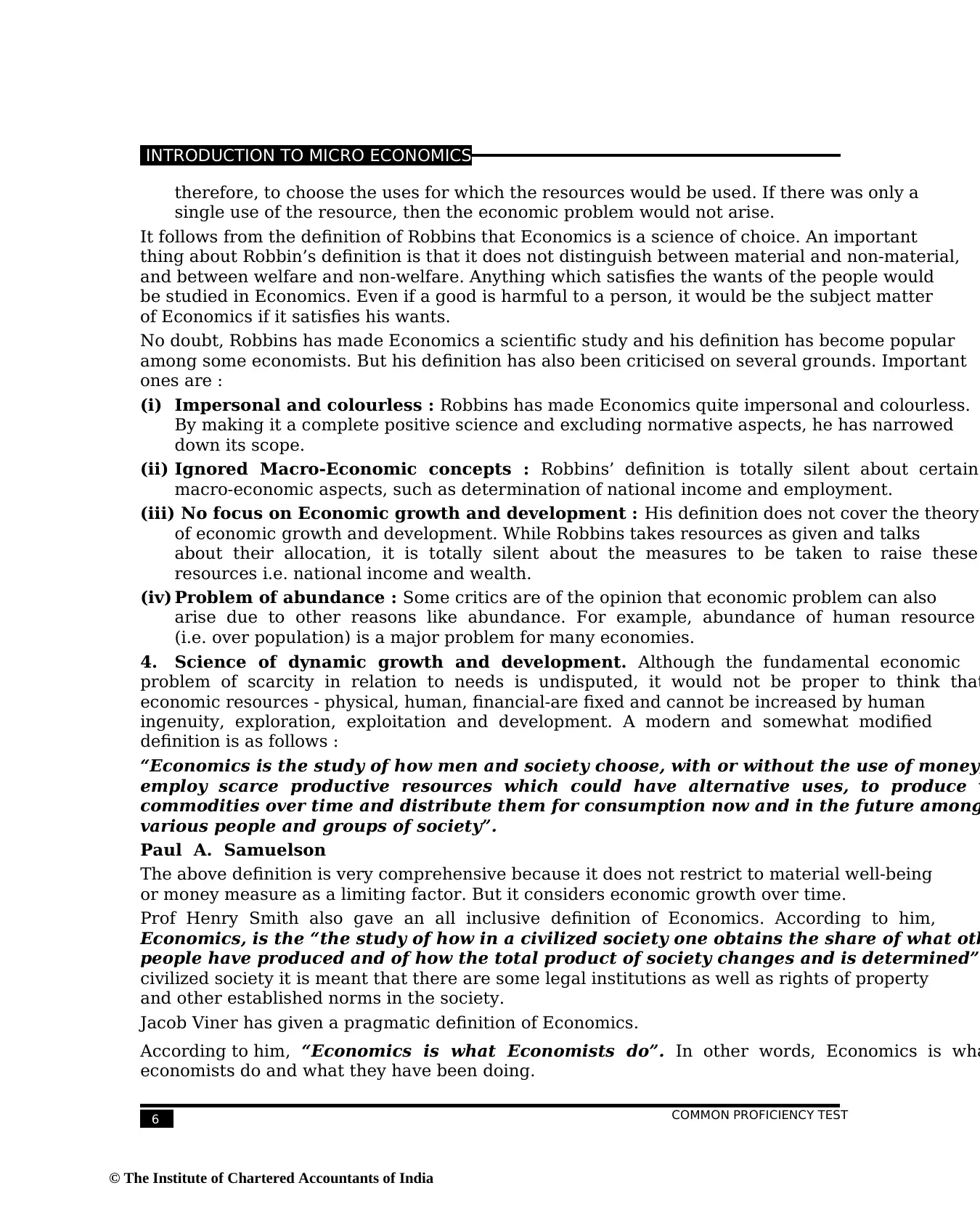
6
INTRODUCTION TO MICRO ECONOMICS
COMMON PROFICIENCY TEST
therefore, to choose the uses for which the resources would be used. If there was only a
single use of the resource, then the economic problem would not arise.
It follows from the definition of Robbins that Economics is a science of choice. An important
thing about Robbin’s definition is that it does not distinguish between material and non-material,
and between welfare and non-welfare. Anything which satisfies the wants of the people would
be studied in Economics. Even if a good is harmful to a person, it would be the subject matter
of Economics if it satisfies his wants.
No doubt, Robbins has made Economics a scientific study and his definition has become popular
among some economists. But his definition has also been criticised on several grounds. Important
ones are :
(i) Impersonal and colourless : Robbins has made Economics quite impersonal and colourless.
By making it a complete positive science and excluding normative aspects, he has narrowed
down its scope.
(ii) Ignored Macro-Economic concepts : Robbins’ definition is totally silent about certain
macro-economic aspects, such as determination of national income and employment.
(iii) No focus on Economic growth and development : His definition does not cover the theory
of economic growth and development. While Robbins takes resources as given and talks
about their allocation, it is totally silent about the measures to be taken to raise these
resources i.e. national income and wealth.
(iv) Problem of abundance : Some critics are of the opinion that economic problem can also
arise due to other reasons like abundance. For example, abundance of human resource
(i.e. over population) is a major problem for many economies.
4. Science of dynamic growth and development. Although the fundamental economic
problem of scarcity in relation to needs is undisputed, it would not be proper to think that
economic resources - physical, human, financial-are fixed and cannot be increased by human
ingenuity, exploration, exploitation and development. A modern and somewhat modified
definition is as follows :
“Economics is the study of how men and society choose, with or without the use of money,
employ scarce productive resources which could have alternative uses, to produce v
commodities over time and distribute them for consumption now and in the future among
various people and groups of society”.
Paul A. Samuelson
The above definition is very comprehensive because it does not restrict to material well-being
or money measure as a limiting factor. But it considers economic growth over time.
Prof Henry Smith also gave an all inclusive definition of Economics. According to him,
Economics, is the “the study of how in a civilized society one obtains the share of what oth
people have produced and of how the total product of society changes and is determined”.
civilized society it is meant that there are some legal institutions as well as rights of property
and other established norms in the society.
Jacob Viner has given a pragmatic definition of Economics.
According to him, “Economics is what Economists do”. In other words, Economics is wha
economists do and what they have been doing.
© The Institute of Chartered Accountants of India
INTRODUCTION TO MICRO ECONOMICS
COMMON PROFICIENCY TEST
therefore, to choose the uses for which the resources would be used. If there was only a
single use of the resource, then the economic problem would not arise.
It follows from the definition of Robbins that Economics is a science of choice. An important
thing about Robbin’s definition is that it does not distinguish between material and non-material,
and between welfare and non-welfare. Anything which satisfies the wants of the people would
be studied in Economics. Even if a good is harmful to a person, it would be the subject matter
of Economics if it satisfies his wants.
No doubt, Robbins has made Economics a scientific study and his definition has become popular
among some economists. But his definition has also been criticised on several grounds. Important
ones are :
(i) Impersonal and colourless : Robbins has made Economics quite impersonal and colourless.
By making it a complete positive science and excluding normative aspects, he has narrowed
down its scope.
(ii) Ignored Macro-Economic concepts : Robbins’ definition is totally silent about certain
macro-economic aspects, such as determination of national income and employment.
(iii) No focus on Economic growth and development : His definition does not cover the theory
of economic growth and development. While Robbins takes resources as given and talks
about their allocation, it is totally silent about the measures to be taken to raise these
resources i.e. national income and wealth.
(iv) Problem of abundance : Some critics are of the opinion that economic problem can also
arise due to other reasons like abundance. For example, abundance of human resource
(i.e. over population) is a major problem for many economies.
4. Science of dynamic growth and development. Although the fundamental economic
problem of scarcity in relation to needs is undisputed, it would not be proper to think that
economic resources - physical, human, financial-are fixed and cannot be increased by human
ingenuity, exploration, exploitation and development. A modern and somewhat modified
definition is as follows :
“Economics is the study of how men and society choose, with or without the use of money,
employ scarce productive resources which could have alternative uses, to produce v
commodities over time and distribute them for consumption now and in the future among
various people and groups of society”.
Paul A. Samuelson
The above definition is very comprehensive because it does not restrict to material well-being
or money measure as a limiting factor. But it considers economic growth over time.
Prof Henry Smith also gave an all inclusive definition of Economics. According to him,
Economics, is the “the study of how in a civilized society one obtains the share of what oth
people have produced and of how the total product of society changes and is determined”.
civilized society it is meant that there are some legal institutions as well as rights of property
and other established norms in the society.
Jacob Viner has given a pragmatic definition of Economics.
According to him, “Economics is what Economists do”. In other words, Economics is wha
economists do and what they have been doing.
© The Institute of Chartered Accountants of India
⊘ This is a preview!⊘
Do you want full access?
Subscribe today to unlock all pages.

Trusted by 1+ million students worldwide
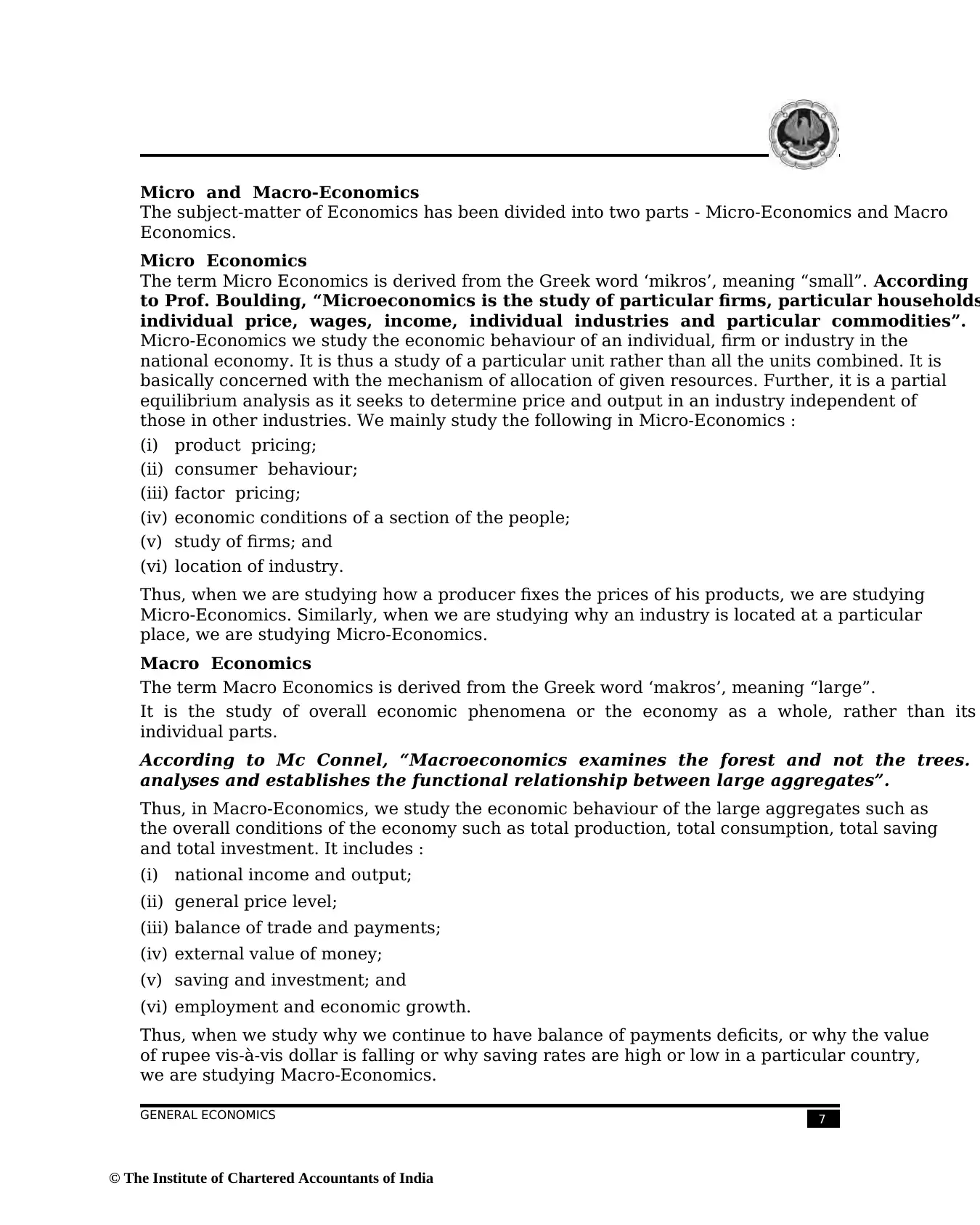
GENERAL ECONOMICS 7
Micro and Macro-Economics
The subject-matter of Economics has been divided into two parts - Micro-Economics and Macro
Economics.
Micro Economics
The term Micro Economics is derived from the Greek word ‘mikros’, meaning “small”. According
to Prof. Boulding, “Microeconomics is the study of particular firms, particular households
individual price, wages, income, individual industries and particular commodities”.
Micro-Economics we study the economic behaviour of an individual, firm or industry in the
national economy. It is thus a study of a particular unit rather than all the units combined. It is
basically concerned with the mechanism of allocation of given resources. Further, it is a partial
equilibrium analysis as it seeks to determine price and output in an industry independent of
those in other industries. We mainly study the following in Micro-Economics :
(i) product pricing;
(ii) consumer behaviour;
(iii) factor pricing;
(iv) economic conditions of a section of the people;
(v) study of firms; and
(vi) location of industry.
Thus, when we are studying how a producer fixes the prices of his products, we are studying
Micro-Economics. Similarly, when we are studying why an industry is located at a particular
place, we are studying Micro-Economics.
Macro Economics
The term Macro Economics is derived from the Greek word ‘makros’, meaning “large”.
It is the study of overall economic phenomena or the economy as a whole, rather than its
individual parts.
According to Mc Connel, “Macroeconomics examines the forest and not the trees.
analyses and establishes the functional relationship between large aggregates”.
Thus, in Macro-Economics, we study the economic behaviour of the large aggregates such as
the overall conditions of the economy such as total production, total consumption, total saving
and total investment. It includes :
(i) national income and output;
(ii) general price level;
(iii) balance of trade and payments;
(iv) external value of money;
(v) saving and investment; and
(vi) employment and economic growth.
Thus, when we study why we continue to have balance of payments deficits, or why the value
of rupee vis-à-vis dollar is falling or why saving rates are high or low in a particular country,
we are studying Macro-Economics.
© The Institute of Chartered Accountants of India
Micro and Macro-Economics
The subject-matter of Economics has been divided into two parts - Micro-Economics and Macro
Economics.
Micro Economics
The term Micro Economics is derived from the Greek word ‘mikros’, meaning “small”. According
to Prof. Boulding, “Microeconomics is the study of particular firms, particular households
individual price, wages, income, individual industries and particular commodities”.
Micro-Economics we study the economic behaviour of an individual, firm or industry in the
national economy. It is thus a study of a particular unit rather than all the units combined. It is
basically concerned with the mechanism of allocation of given resources. Further, it is a partial
equilibrium analysis as it seeks to determine price and output in an industry independent of
those in other industries. We mainly study the following in Micro-Economics :
(i) product pricing;
(ii) consumer behaviour;
(iii) factor pricing;
(iv) economic conditions of a section of the people;
(v) study of firms; and
(vi) location of industry.
Thus, when we are studying how a producer fixes the prices of his products, we are studying
Micro-Economics. Similarly, when we are studying why an industry is located at a particular
place, we are studying Micro-Economics.
Macro Economics
The term Macro Economics is derived from the Greek word ‘makros’, meaning “large”.
It is the study of overall economic phenomena or the economy as a whole, rather than its
individual parts.
According to Mc Connel, “Macroeconomics examines the forest and not the trees.
analyses and establishes the functional relationship between large aggregates”.
Thus, in Macro-Economics, we study the economic behaviour of the large aggregates such as
the overall conditions of the economy such as total production, total consumption, total saving
and total investment. It includes :
(i) national income and output;
(ii) general price level;
(iii) balance of trade and payments;
(iv) external value of money;
(v) saving and investment; and
(vi) employment and economic growth.
Thus, when we study why we continue to have balance of payments deficits, or why the value
of rupee vis-à-vis dollar is falling or why saving rates are high or low in a particular country,
we are studying Macro-Economics.
© The Institute of Chartered Accountants of India
Paraphrase This Document
Need a fresh take? Get an instant paraphrase of this document with our AI Paraphraser
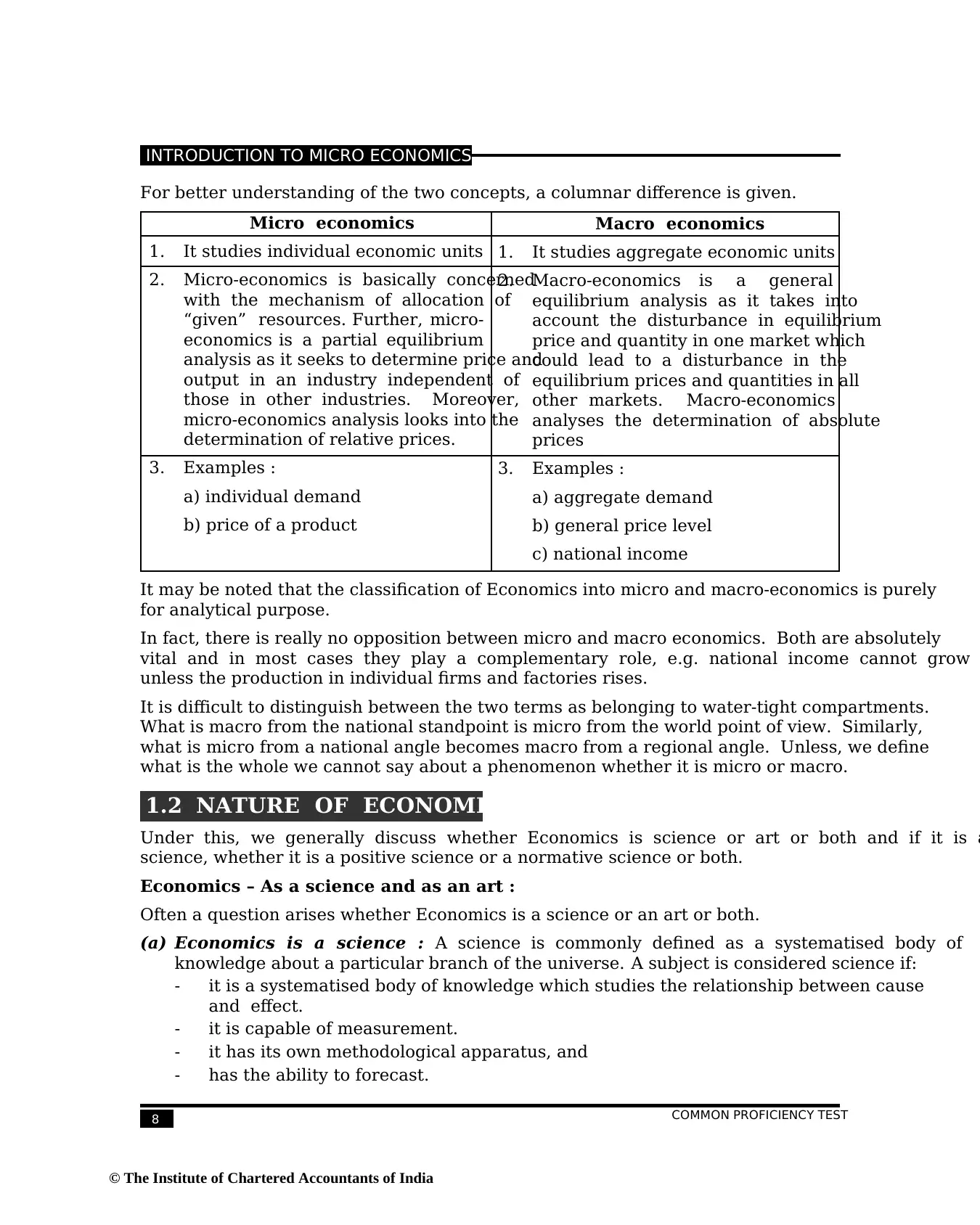
8
INTRODUCTION TO MICRO ECONOMICS
COMMON PROFICIENCY TEST
For better understanding of the two concepts, a columnar difference is given.
It may be noted that the classification of Economics into micro and macro-economics is purely
for analytical purpose.
In fact, there is really no opposition between micro and macro economics. Both are absolutely
vital and in most cases they play a complementary role, e.g. national income cannot grow
unless the production in individual firms and factories rises.
It is difficult to distinguish between the two terms as belonging to water-tight compartments.
What is macro from the national standpoint is micro from the world point of view. Similarly,
what is micro from a national angle becomes macro from a regional angle. Unless, we define
what is the whole we cannot say about a phenomenon whether it is micro or macro.
1.2 NATURE OF ECONOMICS
Under this, we generally discuss whether Economics is science or art or both and if it is a
science, whether it is a positive science or a normative science or both.
Economics – As a science and as an art :
Often a question arises whether Economics is a science or an art or both.
(a) Economics is a science : A science is commonly defined as a systematised body of
knowledge about a particular branch of the universe. A subject is considered science if:
- it is a systematised body of knowledge which studies the relationship between cause
and effect.
- it is capable of measurement.
- it has its own methodological apparatus, and
- has the ability to forecast.
Micro economics
1. It studies individual economic units
2. Micro-economics is basically concerned
with the mechanism of allocation of
“given” resources. Further, micro-
economics is a partial equilibrium
analysis as it seeks to determine price and
output in an industry independent of
those in other industries. Moreover,
micro-economics analysis looks into the
determination of relative prices.
3. Examples :
a) individual demand
b) price of a product
Macro economics
1. It studies aggregate economic units
2. Macro-economics is a general
equilibrium analysis as it takes into
account the disturbance in equilibrium
price and quantity in one market which
could lead to a disturbance in the
equilibrium prices and quantities in all
other markets. Macro-economics
analyses the determination of absolute
prices
3. Examples :
a) aggregate demand
b) general price level
c) national income
© The Institute of Chartered Accountants of India
INTRODUCTION TO MICRO ECONOMICS
COMMON PROFICIENCY TEST
For better understanding of the two concepts, a columnar difference is given.
It may be noted that the classification of Economics into micro and macro-economics is purely
for analytical purpose.
In fact, there is really no opposition between micro and macro economics. Both are absolutely
vital and in most cases they play a complementary role, e.g. national income cannot grow
unless the production in individual firms and factories rises.
It is difficult to distinguish between the two terms as belonging to water-tight compartments.
What is macro from the national standpoint is micro from the world point of view. Similarly,
what is micro from a national angle becomes macro from a regional angle. Unless, we define
what is the whole we cannot say about a phenomenon whether it is micro or macro.
1.2 NATURE OF ECONOMICS
Under this, we generally discuss whether Economics is science or art or both and if it is a
science, whether it is a positive science or a normative science or both.
Economics – As a science and as an art :
Often a question arises whether Economics is a science or an art or both.
(a) Economics is a science : A science is commonly defined as a systematised body of
knowledge about a particular branch of the universe. A subject is considered science if:
- it is a systematised body of knowledge which studies the relationship between cause
and effect.
- it is capable of measurement.
- it has its own methodological apparatus, and
- has the ability to forecast.
Micro economics
1. It studies individual economic units
2. Micro-economics is basically concerned
with the mechanism of allocation of
“given” resources. Further, micro-
economics is a partial equilibrium
analysis as it seeks to determine price and
output in an industry independent of
those in other industries. Moreover,
micro-economics analysis looks into the
determination of relative prices.
3. Examples :
a) individual demand
b) price of a product
Macro economics
1. It studies aggregate economic units
2. Macro-economics is a general
equilibrium analysis as it takes into
account the disturbance in equilibrium
price and quantity in one market which
could lead to a disturbance in the
equilibrium prices and quantities in all
other markets. Macro-economics
analyses the determination of absolute
prices
3. Examples :
a) aggregate demand
b) general price level
c) national income
© The Institute of Chartered Accountants of India
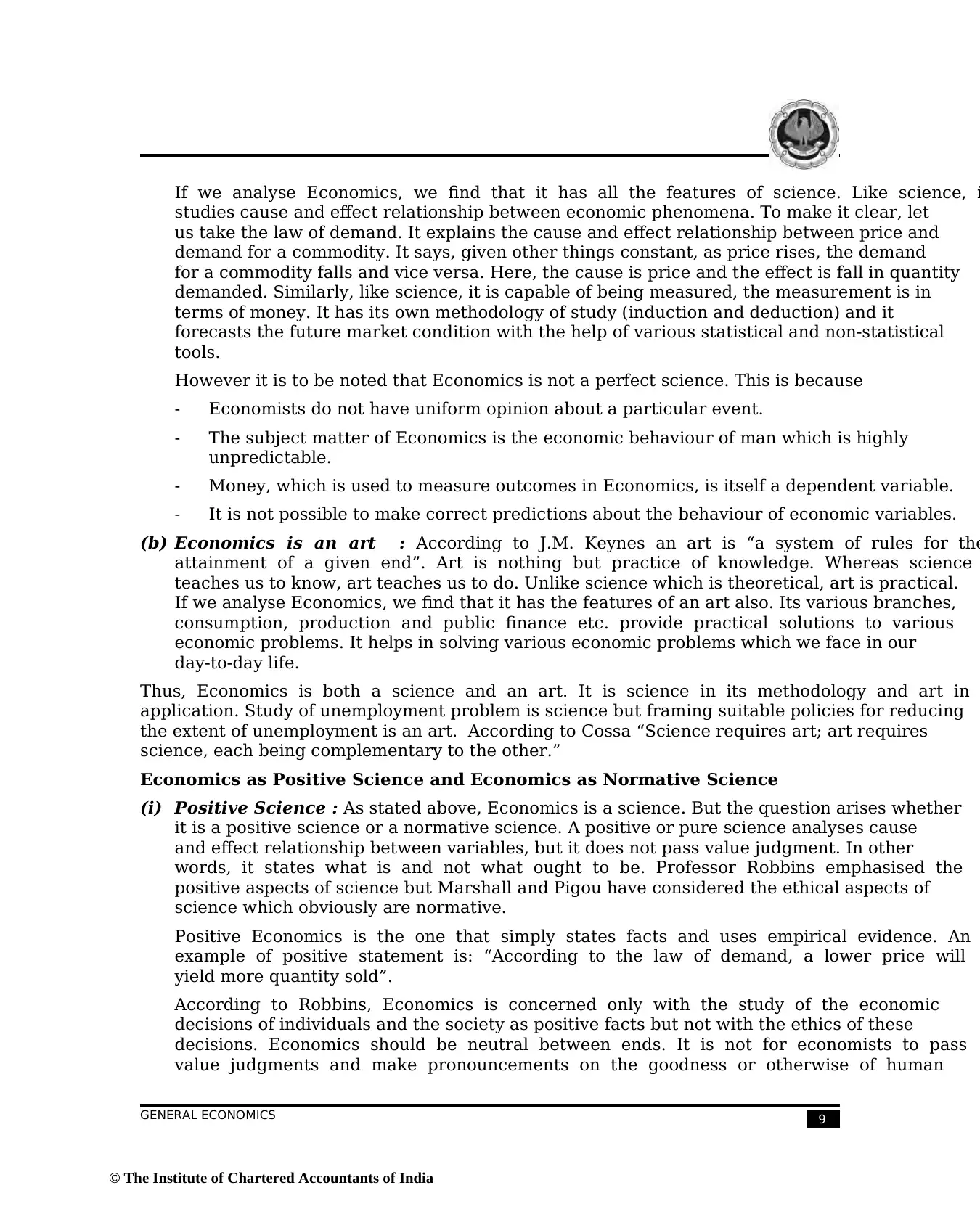
GENERAL ECONOMICS 9
If we analyse Economics, we find that it has all the features of science. Like science, i
studies cause and effect relationship between economic phenomena. To make it clear, let
us take the law of demand. It explains the cause and effect relationship between price and
demand for a commodity. It says, given other things constant, as price rises, the demand
for a commodity falls and vice versa. Here, the cause is price and the effect is fall in quantity
demanded. Similarly, like science, it is capable of being measured, the measurement is in
terms of money. It has its own methodology of study (induction and deduction) and it
forecasts the future market condition with the help of various statistical and non-statistical
tools.
However it is to be noted that Economics is not a perfect science. This is because
- Economists do not have uniform opinion about a particular event.
- The subject matter of Economics is the economic behaviour of man which is highly
unpredictable.
- Money, which is used to measure outcomes in Economics, is itself a dependent variable.
- It is not possible to make correct predictions about the behaviour of economic variables.
(b) Economics is an art : According to J.M. Keynes an art is “a system of rules for the
attainment of a given end”. Art is nothing but practice of knowledge. Whereas science
teaches us to know, art teaches us to do. Unlike science which is theoretical, art is practical.
If we analyse Economics, we find that it has the features of an art also. Its various branches,
consumption, production and public finance etc. provide practical solutions to various
economic problems. It helps in solving various economic problems which we face in our
day-to-day life.
Thus, Economics is both a science and an art. It is science in its methodology and art in
application. Study of unemployment problem is science but framing suitable policies for reducing
the extent of unemployment is an art. According to Cossa “Science requires art; art requires
science, each being complementary to the other.”
Economics as Positive Science and Economics as Normative Science
(i) Positive Science : As stated above, Economics is a science. But the question arises whether
it is a positive science or a normative science. A positive or pure science analyses cause
and effect relationship between variables, but it does not pass value judgment. In other
words, it states what is and not what ought to be. Professor Robbins emphasised the
positive aspects of science but Marshall and Pigou have considered the ethical aspects of
science which obviously are normative.
Positive Economics is the one that simply states facts and uses empirical evidence. An
example of positive statement is: “According to the law of demand, a lower price will
yield more quantity sold”.
According to Robbins, Economics is concerned only with the study of the economic
decisions of individuals and the society as positive facts but not with the ethics of these
decisions. Economics should be neutral between ends. It is not for economists to pass
value judgments and make pronouncements on the goodness or otherwise of human
© The Institute of Chartered Accountants of India
If we analyse Economics, we find that it has all the features of science. Like science, i
studies cause and effect relationship between economic phenomena. To make it clear, let
us take the law of demand. It explains the cause and effect relationship between price and
demand for a commodity. It says, given other things constant, as price rises, the demand
for a commodity falls and vice versa. Here, the cause is price and the effect is fall in quantity
demanded. Similarly, like science, it is capable of being measured, the measurement is in
terms of money. It has its own methodology of study (induction and deduction) and it
forecasts the future market condition with the help of various statistical and non-statistical
tools.
However it is to be noted that Economics is not a perfect science. This is because
- Economists do not have uniform opinion about a particular event.
- The subject matter of Economics is the economic behaviour of man which is highly
unpredictable.
- Money, which is used to measure outcomes in Economics, is itself a dependent variable.
- It is not possible to make correct predictions about the behaviour of economic variables.
(b) Economics is an art : According to J.M. Keynes an art is “a system of rules for the
attainment of a given end”. Art is nothing but practice of knowledge. Whereas science
teaches us to know, art teaches us to do. Unlike science which is theoretical, art is practical.
If we analyse Economics, we find that it has the features of an art also. Its various branches,
consumption, production and public finance etc. provide practical solutions to various
economic problems. It helps in solving various economic problems which we face in our
day-to-day life.
Thus, Economics is both a science and an art. It is science in its methodology and art in
application. Study of unemployment problem is science but framing suitable policies for reducing
the extent of unemployment is an art. According to Cossa “Science requires art; art requires
science, each being complementary to the other.”
Economics as Positive Science and Economics as Normative Science
(i) Positive Science : As stated above, Economics is a science. But the question arises whether
it is a positive science or a normative science. A positive or pure science analyses cause
and effect relationship between variables, but it does not pass value judgment. In other
words, it states what is and not what ought to be. Professor Robbins emphasised the
positive aspects of science but Marshall and Pigou have considered the ethical aspects of
science which obviously are normative.
Positive Economics is the one that simply states facts and uses empirical evidence. An
example of positive statement is: “According to the law of demand, a lower price will
yield more quantity sold”.
According to Robbins, Economics is concerned only with the study of the economic
decisions of individuals and the society as positive facts but not with the ethics of these
decisions. Economics should be neutral between ends. It is not for economists to pass
value judgments and make pronouncements on the goodness or otherwise of human
© The Institute of Chartered Accountants of India
⊘ This is a preview!⊘
Do you want full access?
Subscribe today to unlock all pages.

Trusted by 1+ million students worldwide
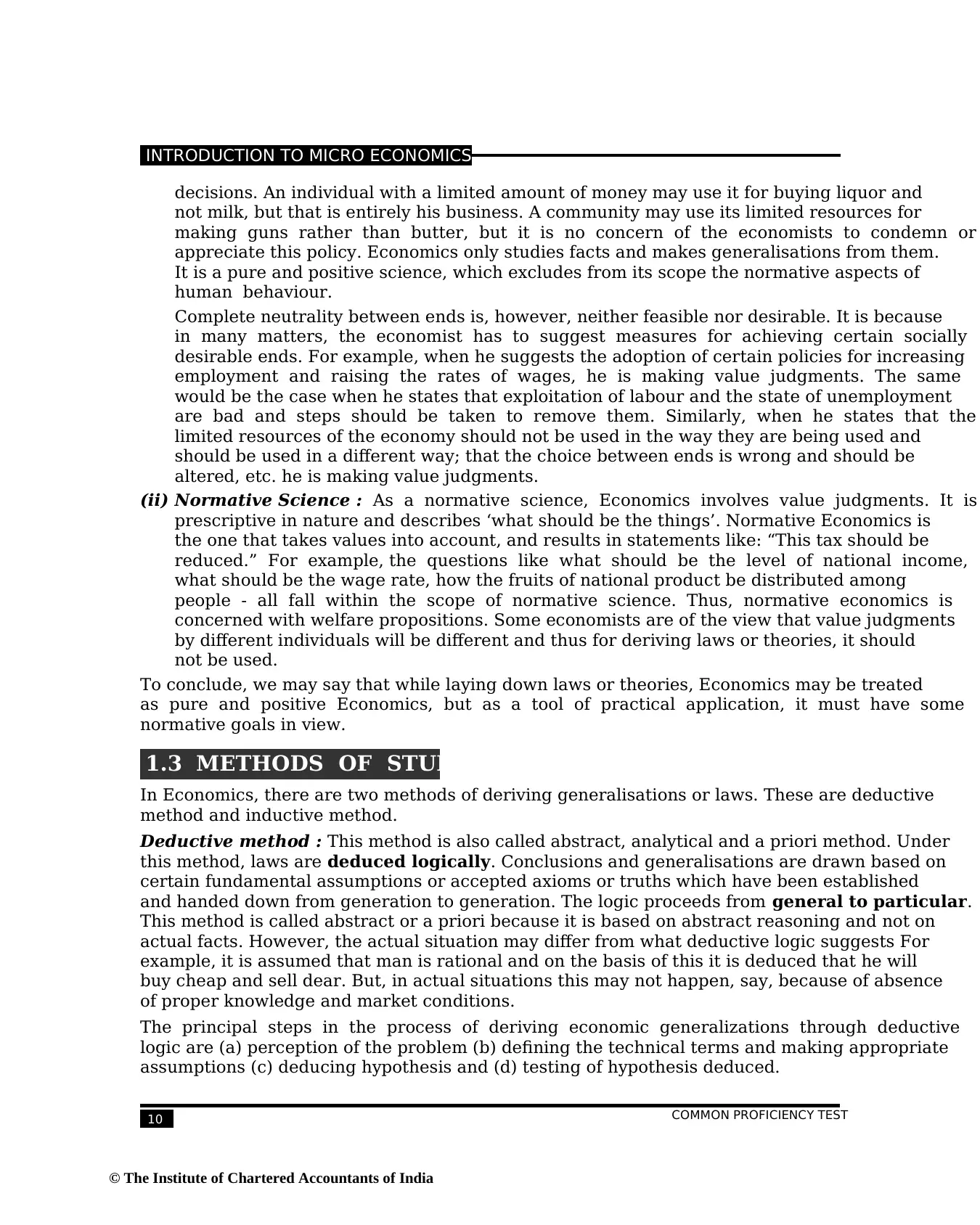
10
INTRODUCTION TO MICRO ECONOMICS
COMMON PROFICIENCY TEST
decisions. An individual with a limited amount of money may use it for buying liquor and
not milk, but that is entirely his business. A community may use its limited resources for
making guns rather than butter, but it is no concern of the economists to condemn or
appreciate this policy. Economics only studies facts and makes generalisations from them.
It is a pure and positive science, which excludes from its scope the normative aspects of
human behaviour.
Complete neutrality between ends is, however, neither feasible nor desirable. It is because
in many matters, the economist has to suggest measures for achieving certain socially
desirable ends. For example, when he suggests the adoption of certain policies for increasing
employment and raising the rates of wages, he is making value judgments. The same
would be the case when he states that exploitation of labour and the state of unemployment
are bad and steps should be taken to remove them. Similarly, when he states that the
limited resources of the economy should not be used in the way they are being used and
should be used in a different way; that the choice between ends is wrong and should be
altered, etc. he is making value judgments.
(ii) Normative Science : As a normative science, Economics involves value judgments. It is
prescriptive in nature and describes ‘what should be the things’. Normative Economics is
the one that takes values into account, and results in statements like: “This tax should be
reduced.” For example, the questions like what should be the level of national income,
what should be the wage rate, how the fruits of national product be distributed among
people - all fall within the scope of normative science. Thus, normative economics is
concerned with welfare propositions. Some economists are of the view that value judgments
by different individuals will be different and thus for deriving laws or theories, it should
not be used.
To conclude, we may say that while laying down laws or theories, Economics may be treated
as pure and positive Economics, but as a tool of practical application, it must have some
normative goals in view.
1.3 METHODS OF STUDY
In Economics, there are two methods of deriving generalisations or laws. These are deductive
method and inductive method.
Deductive method : This method is also called abstract, analytical and a priori method. Under
this method, laws are deduced logically. Conclusions and generalisations are drawn based on
certain fundamental assumptions or accepted axioms or truths which have been established
and handed down from generation to generation. The logic proceeds from general to particular.
This method is called abstract or a priori because it is based on abstract reasoning and not on
actual facts. However, the actual situation may differ from what deductive logic suggests For
example, it is assumed that man is rational and on the basis of this it is deduced that he will
buy cheap and sell dear. But, in actual situations this may not happen, say, because of absence
of proper knowledge and market conditions.
The principal steps in the process of deriving economic generalizations through deductive
logic are (a) perception of the problem (b) defining the technical terms and making appropriate
assumptions (c) deducing hypothesis and (d) testing of hypothesis deduced.
© The Institute of Chartered Accountants of India
INTRODUCTION TO MICRO ECONOMICS
COMMON PROFICIENCY TEST
decisions. An individual with a limited amount of money may use it for buying liquor and
not milk, but that is entirely his business. A community may use its limited resources for
making guns rather than butter, but it is no concern of the economists to condemn or
appreciate this policy. Economics only studies facts and makes generalisations from them.
It is a pure and positive science, which excludes from its scope the normative aspects of
human behaviour.
Complete neutrality between ends is, however, neither feasible nor desirable. It is because
in many matters, the economist has to suggest measures for achieving certain socially
desirable ends. For example, when he suggests the adoption of certain policies for increasing
employment and raising the rates of wages, he is making value judgments. The same
would be the case when he states that exploitation of labour and the state of unemployment
are bad and steps should be taken to remove them. Similarly, when he states that the
limited resources of the economy should not be used in the way they are being used and
should be used in a different way; that the choice between ends is wrong and should be
altered, etc. he is making value judgments.
(ii) Normative Science : As a normative science, Economics involves value judgments. It is
prescriptive in nature and describes ‘what should be the things’. Normative Economics is
the one that takes values into account, and results in statements like: “This tax should be
reduced.” For example, the questions like what should be the level of national income,
what should be the wage rate, how the fruits of national product be distributed among
people - all fall within the scope of normative science. Thus, normative economics is
concerned with welfare propositions. Some economists are of the view that value judgments
by different individuals will be different and thus for deriving laws or theories, it should
not be used.
To conclude, we may say that while laying down laws or theories, Economics may be treated
as pure and positive Economics, but as a tool of practical application, it must have some
normative goals in view.
1.3 METHODS OF STUDY
In Economics, there are two methods of deriving generalisations or laws. These are deductive
method and inductive method.
Deductive method : This method is also called abstract, analytical and a priori method. Under
this method, laws are deduced logically. Conclusions and generalisations are drawn based on
certain fundamental assumptions or accepted axioms or truths which have been established
and handed down from generation to generation. The logic proceeds from general to particular.
This method is called abstract or a priori because it is based on abstract reasoning and not on
actual facts. However, the actual situation may differ from what deductive logic suggests For
example, it is assumed that man is rational and on the basis of this it is deduced that he will
buy cheap and sell dear. But, in actual situations this may not happen, say, because of absence
of proper knowledge and market conditions.
The principal steps in the process of deriving economic generalizations through deductive
logic are (a) perception of the problem (b) defining the technical terms and making appropriate
assumptions (c) deducing hypothesis and (d) testing of hypothesis deduced.
© The Institute of Chartered Accountants of India
Paraphrase This Document
Need a fresh take? Get an instant paraphrase of this document with our AI Paraphraser
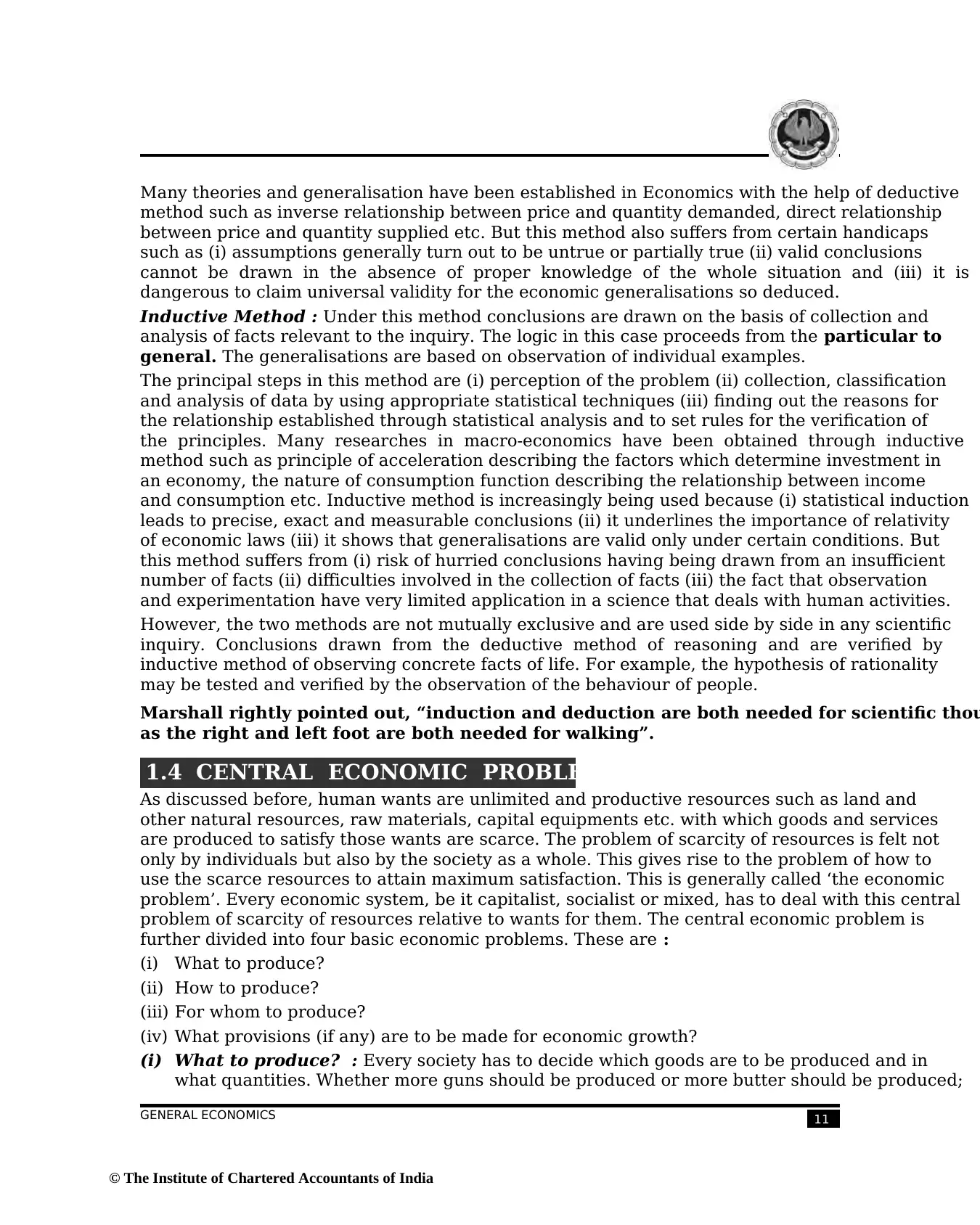
GENERAL ECONOMICS 11
Many theories and generalisation have been established in Economics with the help of deductive
method such as inverse relationship between price and quantity demanded, direct relationship
between price and quantity supplied etc. But this method also suffers from certain handicaps
such as (i) assumptions generally turn out to be untrue or partially true (ii) valid conclusions
cannot be drawn in the absence of proper knowledge of the whole situation and (iii) it is
dangerous to claim universal validity for the economic generalisations so deduced.
Inductive Method : Under this method conclusions are drawn on the basis of collection and
analysis of facts relevant to the inquiry. The logic in this case proceeds from the particular to
general. The generalisations are based on observation of individual examples.
The principal steps in this method are (i) perception of the problem (ii) collection, classification
and analysis of data by using appropriate statistical techniques (iii) finding out the reasons for
the relationship established through statistical analysis and to set rules for the verification of
the principles. Many researches in macro-economics have been obtained through inductive
method such as principle of acceleration describing the factors which determine investment in
an economy, the nature of consumption function describing the relationship between income
and consumption etc. Inductive method is increasingly being used because (i) statistical induction
leads to precise, exact and measurable conclusions (ii) it underlines the importance of relativity
of economic laws (iii) it shows that generalisations are valid only under certain conditions. But
this method suffers from (i) risk of hurried conclusions having being drawn from an insufficient
number of facts (ii) difficulties involved in the collection of facts (iii) the fact that observation
and experimentation have very limited application in a science that deals with human activities.
However, the two methods are not mutually exclusive and are used side by side in any scientific
inquiry. Conclusions drawn from the deductive method of reasoning and are verified by
inductive method of observing concrete facts of life. For example, the hypothesis of rationality
may be tested and verified by the observation of the behaviour of people.
Marshall rightly pointed out, “induction and deduction are both needed for scientific thou
as the right and left foot are both needed for walking”.
1.4 CENTRAL ECONOMIC PROBLEMS
As discussed before, human wants are unlimited and productive resources such as land and
other natural resources, raw materials, capital equipments etc. with which goods and services
are produced to satisfy those wants are scarce. The problem of scarcity of resources is felt not
only by individuals but also by the society as a whole. This gives rise to the problem of how to
use the scarce resources to attain maximum satisfaction. This is generally called ‘the economic
problem’. Every economic system, be it capitalist, socialist or mixed, has to deal with this central
problem of scarcity of resources relative to wants for them. The central economic problem is
further divided into four basic economic problems. These are :
(i) What to produce?
(ii) How to produce?
(iii) For whom to produce?
(iv) What provisions (if any) are to be made for economic growth?
(i) What to produce? : Every society has to decide which goods are to be produced and in
what quantities. Whether more guns should be produced or more butter should be produced;
© The Institute of Chartered Accountants of India
Many theories and generalisation have been established in Economics with the help of deductive
method such as inverse relationship between price and quantity demanded, direct relationship
between price and quantity supplied etc. But this method also suffers from certain handicaps
such as (i) assumptions generally turn out to be untrue or partially true (ii) valid conclusions
cannot be drawn in the absence of proper knowledge of the whole situation and (iii) it is
dangerous to claim universal validity for the economic generalisations so deduced.
Inductive Method : Under this method conclusions are drawn on the basis of collection and
analysis of facts relevant to the inquiry. The logic in this case proceeds from the particular to
general. The generalisations are based on observation of individual examples.
The principal steps in this method are (i) perception of the problem (ii) collection, classification
and analysis of data by using appropriate statistical techniques (iii) finding out the reasons for
the relationship established through statistical analysis and to set rules for the verification of
the principles. Many researches in macro-economics have been obtained through inductive
method such as principle of acceleration describing the factors which determine investment in
an economy, the nature of consumption function describing the relationship between income
and consumption etc. Inductive method is increasingly being used because (i) statistical induction
leads to precise, exact and measurable conclusions (ii) it underlines the importance of relativity
of economic laws (iii) it shows that generalisations are valid only under certain conditions. But
this method suffers from (i) risk of hurried conclusions having being drawn from an insufficient
number of facts (ii) difficulties involved in the collection of facts (iii) the fact that observation
and experimentation have very limited application in a science that deals with human activities.
However, the two methods are not mutually exclusive and are used side by side in any scientific
inquiry. Conclusions drawn from the deductive method of reasoning and are verified by
inductive method of observing concrete facts of life. For example, the hypothesis of rationality
may be tested and verified by the observation of the behaviour of people.
Marshall rightly pointed out, “induction and deduction are both needed for scientific thou
as the right and left foot are both needed for walking”.
1.4 CENTRAL ECONOMIC PROBLEMS
As discussed before, human wants are unlimited and productive resources such as land and
other natural resources, raw materials, capital equipments etc. with which goods and services
are produced to satisfy those wants are scarce. The problem of scarcity of resources is felt not
only by individuals but also by the society as a whole. This gives rise to the problem of how to
use the scarce resources to attain maximum satisfaction. This is generally called ‘the economic
problem’. Every economic system, be it capitalist, socialist or mixed, has to deal with this central
problem of scarcity of resources relative to wants for them. The central economic problem is
further divided into four basic economic problems. These are :
(i) What to produce?
(ii) How to produce?
(iii) For whom to produce?
(iv) What provisions (if any) are to be made for economic growth?
(i) What to produce? : Every society has to decide which goods are to be produced and in
what quantities. Whether more guns should be produced or more butter should be produced;
© The Institute of Chartered Accountants of India
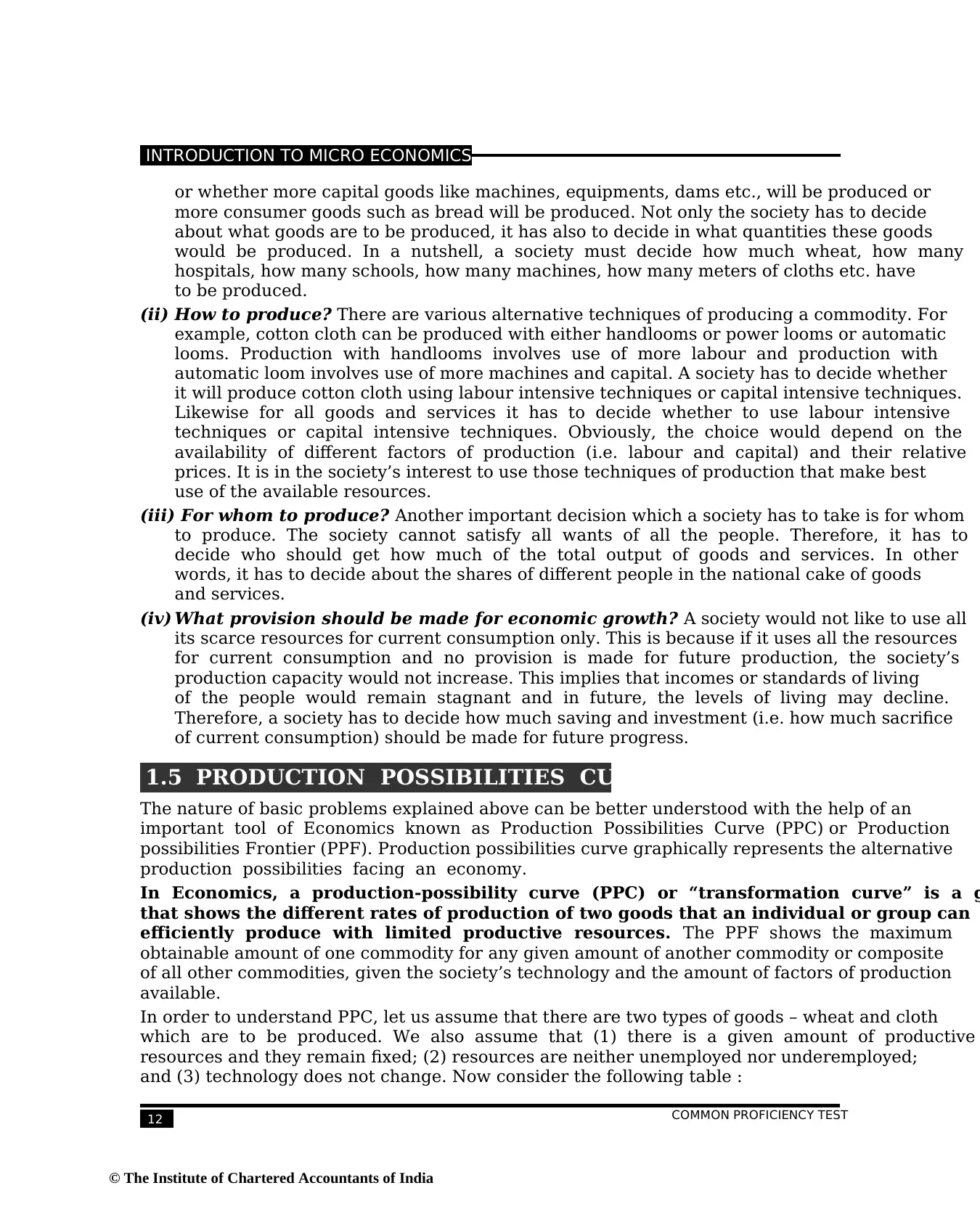
12
INTRODUCTION TO MICRO ECONOMICS
COMMON PROFICIENCY TEST
or whether more capital goods like machines, equipments, dams etc., will be produced or
more consumer goods such as bread will be produced. Not only the society has to decide
about what goods are to be produced, it has also to decide in what quantities these goods
would be produced. In a nutshell, a society must decide how much wheat, how many
hospitals, how many schools, how many machines, how many meters of cloths etc. have
to be produced.
(ii) How to produce? There are various alternative techniques of producing a commodity. For
example, cotton cloth can be produced with either handlooms or power looms or automatic
looms. Production with handlooms involves use of more labour and production with
automatic loom involves use of more machines and capital. A society has to decide whether
it will produce cotton cloth using labour intensive techniques or capital intensive techniques.
Likewise for all goods and services it has to decide whether to use labour intensive
techniques or capital intensive techniques. Obviously, the choice would depend on the
availability of different factors of production (i.e. labour and capital) and their relative
prices. It is in the society’s interest to use those techniques of production that make best
use of the available resources.
(iii) For whom to produce? Another important decision which a society has to take is for whom
to produce. The society cannot satisfy all wants of all the people. Therefore, it has to
decide who should get how much of the total output of goods and services. In other
words, it has to decide about the shares of different people in the national cake of goods
and services.
(iv) What provision should be made for economic growth? A society would not like to use all
its scarce resources for current consumption only. This is because if it uses all the resources
for current consumption and no provision is made for future production, the society’s
production capacity would not increase. This implies that incomes or standards of living
of the people would remain stagnant and in future, the levels of living may decline.
Therefore, a society has to decide how much saving and investment (i.e. how much sacrifice
of current consumption) should be made for future progress.
1.5 PRODUCTION POSSIBILITIES CURVE
The nature of basic problems explained above can be better understood with the help of an
important tool of Economics known as Production Possibilities Curve (PPC) or Production
possibilities Frontier (PPF). Production possibilities curve graphically represents the alternative
production possibilities facing an economy.
In Economics, a production-possibility curve (PPC) or “transformation curve” is a g
that shows the different rates of production of two goods that an individual or group can
efficiently produce with limited productive resources. The PPF shows the maximum
obtainable amount of one commodity for any given amount of another commodity or composite
of all other commodities, given the society’s technology and the amount of factors of production
available.
In order to understand PPC, let us assume that there are two types of goods – wheat and cloth
which are to be produced. We also assume that (1) there is a given amount of productive
resources and they remain fixed; (2) resources are neither unemployed nor underemployed;
and (3) technology does not change. Now consider the following table :
© The Institute of Chartered Accountants of India
INTRODUCTION TO MICRO ECONOMICS
COMMON PROFICIENCY TEST
or whether more capital goods like machines, equipments, dams etc., will be produced or
more consumer goods such as bread will be produced. Not only the society has to decide
about what goods are to be produced, it has also to decide in what quantities these goods
would be produced. In a nutshell, a society must decide how much wheat, how many
hospitals, how many schools, how many machines, how many meters of cloths etc. have
to be produced.
(ii) How to produce? There are various alternative techniques of producing a commodity. For
example, cotton cloth can be produced with either handlooms or power looms or automatic
looms. Production with handlooms involves use of more labour and production with
automatic loom involves use of more machines and capital. A society has to decide whether
it will produce cotton cloth using labour intensive techniques or capital intensive techniques.
Likewise for all goods and services it has to decide whether to use labour intensive
techniques or capital intensive techniques. Obviously, the choice would depend on the
availability of different factors of production (i.e. labour and capital) and their relative
prices. It is in the society’s interest to use those techniques of production that make best
use of the available resources.
(iii) For whom to produce? Another important decision which a society has to take is for whom
to produce. The society cannot satisfy all wants of all the people. Therefore, it has to
decide who should get how much of the total output of goods and services. In other
words, it has to decide about the shares of different people in the national cake of goods
and services.
(iv) What provision should be made for economic growth? A society would not like to use all
its scarce resources for current consumption only. This is because if it uses all the resources
for current consumption and no provision is made for future production, the society’s
production capacity would not increase. This implies that incomes or standards of living
of the people would remain stagnant and in future, the levels of living may decline.
Therefore, a society has to decide how much saving and investment (i.e. how much sacrifice
of current consumption) should be made for future progress.
1.5 PRODUCTION POSSIBILITIES CURVE
The nature of basic problems explained above can be better understood with the help of an
important tool of Economics known as Production Possibilities Curve (PPC) or Production
possibilities Frontier (PPF). Production possibilities curve graphically represents the alternative
production possibilities facing an economy.
In Economics, a production-possibility curve (PPC) or “transformation curve” is a g
that shows the different rates of production of two goods that an individual or group can
efficiently produce with limited productive resources. The PPF shows the maximum
obtainable amount of one commodity for any given amount of another commodity or composite
of all other commodities, given the society’s technology and the amount of factors of production
available.
In order to understand PPC, let us assume that there are two types of goods – wheat and cloth
which are to be produced. We also assume that (1) there is a given amount of productive
resources and they remain fixed; (2) resources are neither unemployed nor underemployed;
and (3) technology does not change. Now consider the following table :
© The Institute of Chartered Accountants of India
⊘ This is a preview!⊘
Do you want full access?
Subscribe today to unlock all pages.

Trusted by 1+ million students worldwide
1 out of 35
Related Documents
Your All-in-One AI-Powered Toolkit for Academic Success.
+13062052269
info@desklib.com
Available 24*7 on WhatsApp / Email
![[object Object]](/_next/static/media/star-bottom.7253800d.svg)
Unlock your academic potential
Copyright © 2020–2025 A2Z Services. All Rights Reserved. Developed and managed by ZUCOL.




